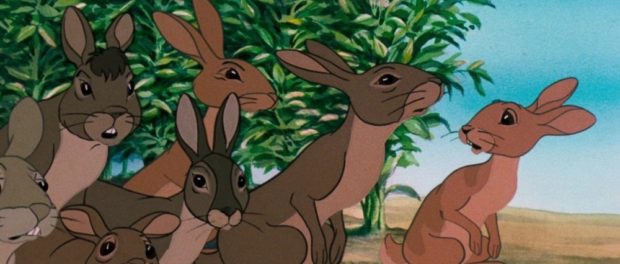Book of the Month Club: Watership Down by Richard Adams
Imagine this: an animated movie about rabbits. It sounds like a G-rated film, perhaps PG would even be stretching it. Nothing can go wrong, right? Perhaps you weren’t watching Watership Down, a film that despite its G-rating in its era, is still one of the bloodiest and graphically violent children’s movies ever. With Adams’ death last year, I picked up my old copy of his first novel in order to revisit it with a new pair of eyes.
Reading through any book with a new perspective is always rewarding. On the surface, it tells the story of Hazel and his brother Fiver as they gather together a band of brothers to journey to a new land. However, more is going on here. The root of the story is a very old one, told and retold and even retold in the book itself: it is that of the Hero’s Journey of a character that goes from one of the common folk to a true hero. The epigraphs, borrowed from classic and contemporary literature, also hint at the novel’s deeper connections with Ancient Greek plays and folk legends. One particular thing that stuck out for me was the political imagery. While Adams had claimed that his book was merely something for his children to enjoy, the political overtones of each society that Hazel and his band encounter are visible just beneath the surface if you dig deep (pun intended). Sandleford Warren, where the story starts, is a strict, hierarchical society. Cowslip’s Warren is concerned chiefly with the individual and is perhaps a warning of the consequences of the concept of an individual right taken to its extreme. Efrafa is a darker form of where the story began, where the individual is suppressed with a strict militia and whose masses are ruled by a despotic leader. The titular Watership Down, however, is supposed to be an idyllic place of happiness, ruled by merit and not by strength.
Each major segment of the book is divided into one “act”, each chapter is prefaced by an epigraph that foreshadows or comments on the events occurring in that segment. From a technical viewpoint, this is also where this book excels. The book manages to avoid a “second act sag” where all too often an author fails to keep an audience’s interest. Each chapter manages to convey a plot point to advance the story forward, and though part of the action during the climax of the novel might literally be a bit contrived (as hinted by the author in the chapter title), the story resolves itself nonetheless in a satisfying manner. The stories of a fictional folk hero, El-ahrairah, a form of rabbit “Robin Hood” or similar Prince of Thieves, are charming and while they can, for the most part, be skipped without detriment to the main story, they add a lot of flavour to a fictional society that Adams manages to craft out of few details. These few details about the rabbit society leaves a lot to the imagination, which in some ways is a good thing, though at some points, I wish Adams had given some form of explanation to the hierarchy and its rules.
Mention “talking animals” and most readers will assume this is a children’s book. Watership Down is not the case, at least not entirely. In a sense, at its purest form, a children’s book it is and will be to many generations growing up. Its lexicon is appropriate for older children who are able to sustain a longer novel, but the imagery, allusions, and themes behind it are coming from literature that they would not necessarily be familiar with. Read it with an open mind.
Watership Down was adapted into a film in 1978 and stars the voice talents of John Hurt, Richard Briers, and Zero Mostel.






